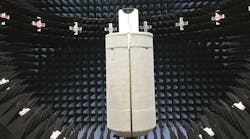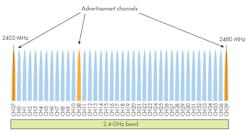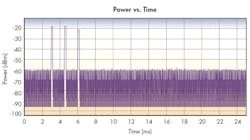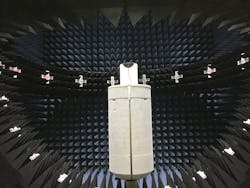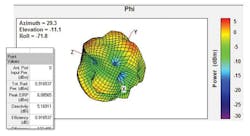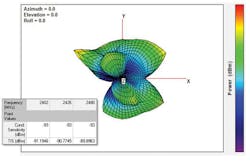BLE Antenna Testing Helps Optimize IoT Device Performance
Download this article in PDF format.
Many new Internet of Things (IoT) devices rely on wireless technology as their primary or only method of communication. Tight constraints on power, size, and cost make it very challenging to design and manufacture devices with good RF (wireless) performance, though. Particularly challenging is antenna performance, because its small size and close proximity to other components create problems in achieving good impedance matching and a good isotropic antenna radiation pattern.
Characterizing this antenna performance requires specialized over-the-air (OTA) measurement techniques that, until recently, have not been available for Bluetooth Low Energy (BLE) technology. To meet that need, ETS-Lindgren and LitePoint partnered up to produce the first BLE OTA antenna measurement system. This article describes how BLE antenna measurement can optimize device performance to boost customer satisfaction.
To validate how well a device’s antenna is expected to perform in a real-world application, engineers typically use total radiated power (TRP), total isotropic sensitivity (TIS), and antenna radiation patterns in vertical and horizontal polarization to characterize and compare device performance. The transmitter measurements indicate how much total RF power the device transmits and how evenly this power is distributed around a far-field sphere. Similarly, the receiver measurements determine the total integrated sensitivity while receiving RF signals from all directions. These measurements, which have been used effectively for many years with cellular and Wi-Fi technologies, recently became available for BLE devices.
1. BLE utilizes advertising channels at frequencies of 2402, 2426, and 2480 MHz.
Going Over the Air
By applying properties of all BLE devices, engineers can leverage an OTA test solution to quickly and accurately measure BLE transmitter power and receiver sensitivity. BLE devices all transmit on specific RF frequencies, known as advertising channels, as a beacon to other BLE receivers (Fig. 1). These advertising channels are well-distributed across the entire 2.4-GHz band, at frequencies of 2402, 2426, and 2480 MHz. Using these three channels to characterize RF performance provides engineers with high confidence that the device is working effectively across the entire band.
When a BLE device “wakes up,” it will rapidly transmit advertisement packets on all advertising channels within a period of a few milliseconds. Figure 2 shows a power-versus-time capture that illustrates the three advertisements in rapid succession. If, during this time, the device does not receive any requests from other devices, it will go back to sleep and repeat this process a short while later—typically within 1 to 10 seconds. This BLE characteristic can be used to rapidly and accurately measure transmitter output power on these three RF channels.
2. This figure illustrates three rapidly transmitted advertisements.
Using an anechoic chamber with multiple antennas positioned in a ring and a movable pedestal that holds the BLE device, these transmitter measurements are performed at various positions around a 360-degree sphere. Figure 3 shows an anechoic chamber, ring antenna, and pedestal with a BLE device mounted on top.
These transmitter measurements are performed at 15-degree increments, creating an accurate representation of the transmitter radiation pattern. By applying calibration data and integrating results from all measurements, the TRP is calculated to determine how much power the device is transmitting. In an ideal case, the antenna would be 100% efficient and all power from the device would be radiated outward.
3. Transmitter measurements are performed in an anechoic chamber to determine the transmitter radiation pattern.
Also, because a mobile device transmitter doesn’t know the direction of the receiving device, the ideal antenna pattern is typically “isotropic”—meaning that it radiates equally in all directions. Of course, getting to the ideal radiation pattern and TRP is the goal. But realistically the antenna cannot be 100% efficient; the antenna pattern will inevitably have some nulls.
With an OTA measurement system, engineers can easily characterize their device, make design improvements, and then rapidly evaluate the impact of those changes. Figure 4 shows an antenna radiation pattern and TRP results from an actual BLE device.
4. This antenna radiation pattern and TRP were the result of an OTA test on a BLE device.
Receiver Sensitivity
Receiver sensitivity is always a more complex and more time-consuming measurement. But it is just as critical as transmitter performance, and is characterized using a similar method. Whenever a BLE device transmits an advertising packet, it listens for a brief period of time to determine if other BLE devices are trying to communicate with it. During this short but precise time, an OTA test solution may send a special Bluetooth message on the advertising channel, known as a scan request, to determine if the BLE device can receive the message from the tester.
If the device does receive the message, it acknowledges the scan request with a scan response message. This “ACK” message from the BLE device indicates the receiver properly received the packet. The test system sweeps the RF power through a range of different levels to determine the minimum point where the BLE device can reliably receive packets.
This methodology of using advertising packets, scan request, and scan response messages allows the test system to accurately measure the BLE device packet-error-rate (PER) at various RF levels and determine receiver sensitivity. Just like the transmitter measurements, receiver performance is measured at a variety of positions around the sphere. The TIS is calculated using calibration data and integration of all measurement results. Figure 5 shows a receiver antenna pattern and TIS from an actual BLE device.
5. An OTA test on an actual BLE device produced this receiver antenna pattern and TIS.
A far-field anechoic chamber has very high RF path losses. The calibration of this chamber and the associated components is a critical part of making accurate RF measurements. To calibrate the chamber, a calibrated dipole radiator with known performance is placed on the pedestal where the BLE device will be positioned. The calibrated radiator is used to measure path loss between the “testing position” and the measurement ring that contains both horizontal and vertical measurement antennas.
In addition to losses due to the OTA distance, switches, RF cables, and RF amplifiers are characterized as part of the system calibration. This careful attention to detail allows typical BLE measurements to have about 2-dB measurement accuracy—although achieving better accuracy is possible using more measurements and, therefore, longer test times.
For IoT, if the wireless technology doesn’t work well, the device doesn’t work well and customers won’t be satisfied. With a BLE OTA testing solution, engineers get clear visual and parametric insights into how their designs are performing, and can use this knowledge to improve and optimize performance to ensure customers have the best possible user experience. With powerful and easy-to-use test solutions, engineers can focus their expertise on improving their design and getting products more rapidly out of the lab and into the market.
